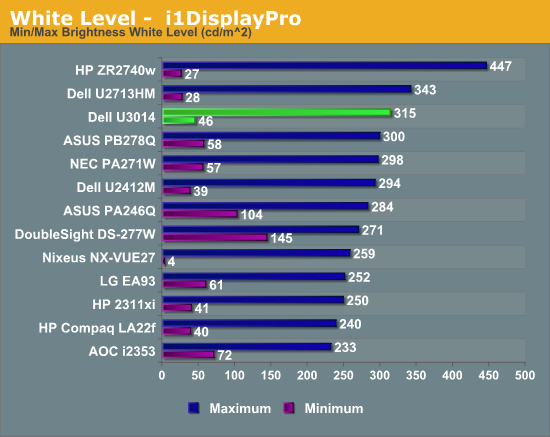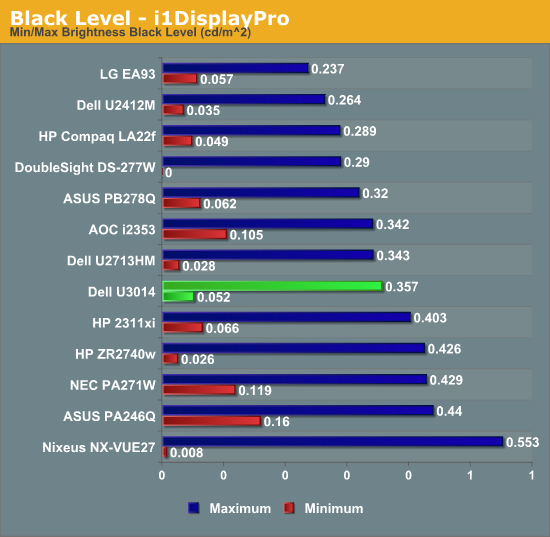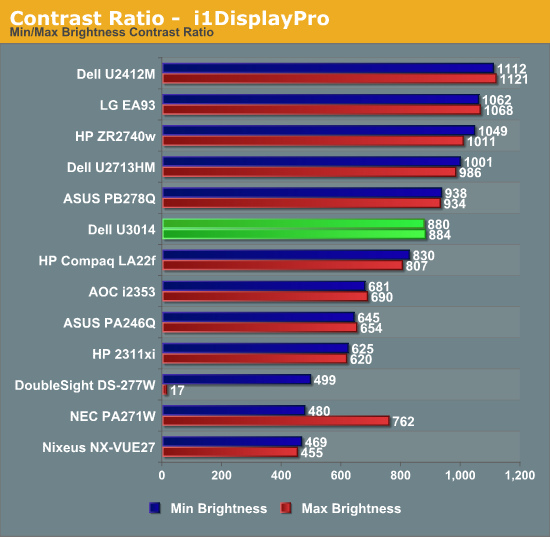Dell U3014 LCD Review
by Chris Heinonen on April 15, 2013 2:00 PM ESTThe Dell U3014 is rated for 350 cd/m2 on the spec sheet, but I found the most I could get it to produce was 315 cd/m2. It would likely produce more if you were to push the contrast all the way to the maximum, but doing so clips the top whites, so all your highlights suddenly become a single shade instead of distinct. It might make the numbers look worse, but not allowing clipping makes for an honest number, and 315 cd/m2 is what the U3014 can do. With the backlight at the minimum, it drops down to only 45 cd/m2 of light, which is good. That gives you lots of room to work with, and most users will be fine with these levels.

Black levels with the backlight at maximum are 0.357 cd/m2, and that drops down to 0.052 cd/m2 at minimum backlight. Dell offers a dynamic backlight on their displays where a pure black screen totally disables the backlights, giving you “infinite” contrast, but that option is disabled in the most color-accurate modes. It also seems be an all-or-nothing approach, and not one where you can selectively enable and disable part of the edge lighting. I’m not a fan of dynamic backlighting unless you have a full backlit LED array, where you can enable and disable it for parts of the screen at once, and find they are usually just tricks to make their contrast numbers seem better than they are. Dell is honest and gives you real and dynamic numbers in their specs, though.

These numbers wind up giving us a contrast ratio in the area of around 900:1. This is maintained from 0-100 percent on the backlight intensity, so it’s an honest 900:1 contrast ratio from the Dell U3014. There are some recent displays that have hit closer to 1,100:1 but these numbers are still quite good overall, and maintaining it across the whole range of brightness is ideal.

This is a decent start for the U3014, but the real question for me is if they can keep the colors accurate in all color spaces with that new G-B LED backlight system.










84 Comments
View All Comments
JDG1980 - Monday, April 15, 2013 - link
It was just reported today that a no-name vendor is releasing a 50" 4K TV for $1500 (the same price as this Dell monitor). I hadn't expected prices to drop that quickly. Although this particular 4K TV probably isn't suitable for monitor use (too big, not clear if it supports 60 Hz, probably has a crappy TN panel) it would be great if it was the leading edge of a new wave of inexpensive 4K TV sets. If there was a 32" 4K TV that supported 60 Hz input (HDMI only goes up to 24 Hz at that resolution, you need DisplayPort for 60) and was reasonably priced, it would make an awesome computer monitor with better DPI than pretty much any existing desktop solution. Hopefully we won't have to wait too much longer for this.cheinonen - Monday, April 15, 2013 - link
Sharp has a 32", 4K display but I believe the MSRP on it is around $6,000. I also believe that it has issues running at 60Hz over a single DisplayLink, but the person I know with one was still working on this issue. So one exists, but it costs a fortune right now. For that $1,500, 50" 4K, I really can't imagine how they're getting there with any sort of quality right now, but we will see.Andrea deluxe - Monday, April 15, 2013 - link
ok... year 2013 and 33ms of input lag?dell and company... are you kidding people?
DanNeely - Monday, April 15, 2013 - link
They're not kidding anyone; they're targeting people for whom the perfect color balance that requires two frames of processing to achieve is more important than getting a latency score that doesn't matter outside of gaming.hackztor - Monday, April 15, 2013 - link
Low input lag can be had in the 3007wfp-hc (I still use this as my main gaming monitor, and 3011 as my secondary). This monitor did not include a scaler so input lag was low, now all monitors want to put hdmi and display port on so they can be used with consoles hence higher input lag.kasakka - Wednesday, April 17, 2013 - link
But the scaler has long been one of the best parts of the high res Dells. I've been using a Dell 3008WFP for years now and due to the high res, many new games just aren't playable at native resolution without multiple GPUs. Thanks to the scaler, I'm happily playing at 1920x1200 which runs well at full detail. Compared to leaving scaling to the GPU, the scaler on the Dell does a far better job resulting in much less blurry picture.For the record I have not been bothered by the input lag either, which I think was reported being somewhere between 20-30ms on the 3008WFP.
mike55 - Monday, April 15, 2013 - link
As Chris mentioned, TFT Central found that there was very little input lag in game mode. ~3.2 ms for pixel response time, and virtually no signal processing time. I'm confused as to why the results are different. Why would using an oscilloscope produce different results?bebimbap - Monday, April 15, 2013 - link
If you are even thinking about gaming on a 60hz monitor you shouldn't be complaining about 33ms input lag coming out of this one. If a frame is 16.7ms @60hz 33ms is 2 frames, compared to using a 144hz of only 6.9ms per frame, or ~5 frames in 33ms. So even though you are missing only every other frame in reactivity compared to a quicker 60hz monitor, you are missing 4 out of 5 frames compared to a 144hz.if you need something faster you could always go for a TN based benq or asus 144hz 24"/27" gaming monitor they have 1-2ms input lag and lightboost but only up to 120hz.
I have both a u3011 and a vg248qe and I cannot game on my u3011 anymore after gaming on a vg248qe @120hz with lightboost. But I do everything else on the u3011, photoshop, movies, browsing, etc, again everything other than gaming. when i'm not gaming the vg248qe acts as a nice blank screen or pallet space for photoshop.
again if input lag is important to you, get a TN based 144hz asus or benq you will be VERY happy. do not look at PLS/PVA/IPS it's just a waste of time.
mayankleoboy1 - Monday, April 15, 2013 - link
Remember, they are the same people who put extreme crappy 1366x768 panels on notebooks.So shittyness is synonymous with Dell.
cheinonen - Tuesday, April 16, 2013 - link
Everyone still puts 1366x768 panels in laptops, as I noticed my Dad's Sony and sister's Acer both rocking those on vacation a couple weeks ago. I wouldn't say that's a Dell problem, but an industry problem.